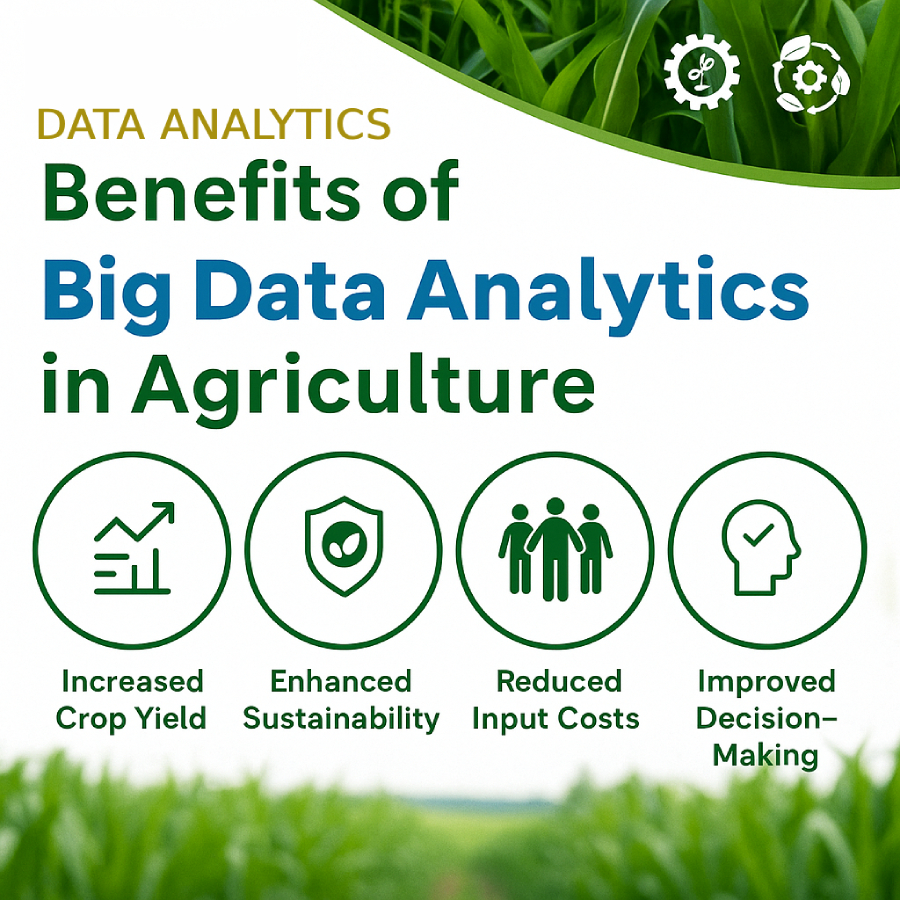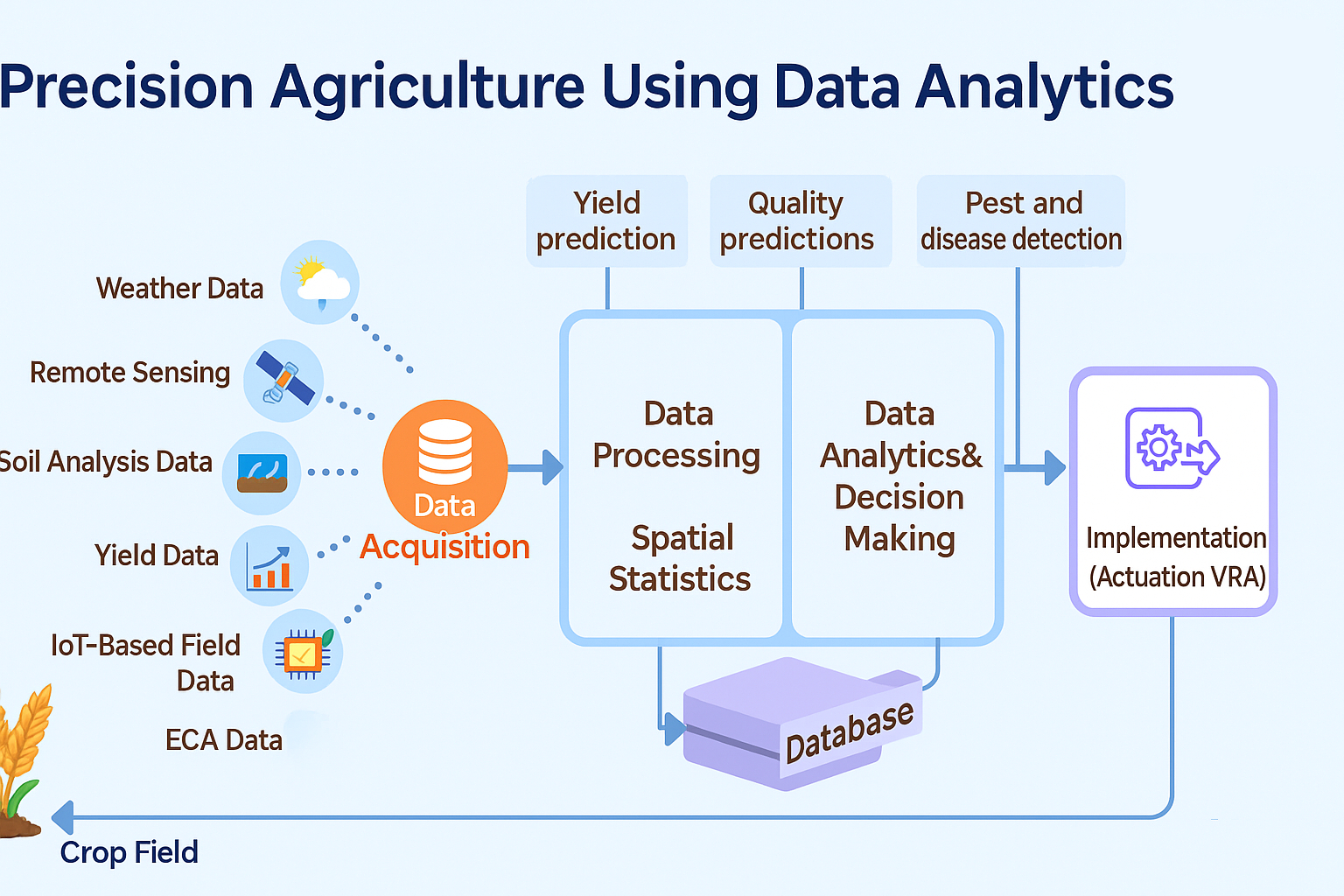Explore how agricultural data analytics is revolutionizing modern farming in 2025. Learn how farmers use IoT, AI, and big data for smarter decisions, higher yields, and sustainable practices.
Agriculture is no longer solely reliant on traditional practices and intuition. In today’s fast-evolving world, data-driven decision-making has emerged as a game-changer, redefining how farms operate and thrive. Agricultural data analytics lies at the core of this transformation, enabling farmers to leverage vast volumes of data for smarter, more sustainable practices.
From soil health and weather forecasting to pest detection and yield prediction, data analytics provides a powerful toolkit to maximize productivity while minimizing waste and environmental impact. This article explores the importance, tools, technologies, applications, and future of agricultural data analytics in 2025.
Table of Contents
What is Agricultural Data Analytics?
Agricultural data analytics refers to the collection, processing, and interpretation of agricultural data using analytical tools and techniques. It involves transforming raw farm data into actionable insights that help improve decision-making and resource management across all stages of the crop cycle.
Types of Agricultural Data:
- Weather Data (temperature, rainfall, humidity)
- Soil Data (pH, moisture, nutrients)
- Crop Data (growth stages, yield estimates)
- Machine Data (tractor GPS, fuel usage)
- Market Data (pricing trends, demand)
- Remote Sensing Data (satellite/drone imagery)
By applying big data analytics, machine learning, and IoT (Internet of Things), farmers and agribusinesses gain a clearer picture of what’s happening on the farm—enabling precision agriculture.
Importance of Data Analytics in Agriculture
Here are some compelling reasons why agricultural data analytics is critical in 2025:
1. Enhanced Crop Yields
Farmers can use predictive analytics to choose the best crop varieties, planting dates, and irrigation methods, resulting in higher productivity.
2. Efficient Resource Utilization
Analytics help determine how much water, fertilizer, and pesticide is needed, avoiding both shortages and overuse.
3. Early Pest and Disease Detection
By analyzing sensor and visual data, farmers can detect and treat issues before they become widespread.
4. Climate Resilience
With climate change becoming a major concern, data helps farmers adapt by forecasting weather patterns and minimizing risks.
5. Better Market Decisions
Market analytics give insights into commodity prices, allowing farmers to sell at optimal times and increase profits.
Technologies Powering Agricultural Data Analytics
To understand how data analytics is integrated into farming, it’s important to look at the technologies enabling it:
✅ 1. IoT Devices
Sensors placed in fields and on equipment continuously collect data on soil conditions, crop health, and environmental changes.
✅ 2. Remote Sensing
Satellite and drone imagery provide bird’s-eye views of fields to detect crop stress, moisture deficits, or disease patches.
✅ 3. Artificial Intelligence (AI)
AI algorithms process complex datasets to generate forecasts, classify plant diseases, or automate decision-making.
✅ 4. Cloud Computing
Data from multiple sources is stored and analyzed in the cloud, making it accessible in real-time from any location.
✅ 5. GIS (Geographic Information Systems)
Maps generated from spatial data allow for zone-specific farming strategies.
✅ 6. Big Data Platforms
These platforms handle massive datasets from different inputs and provide dashboards and reports for easy interpretation.

Applications of Data Analytics in Agriculture
Let’s explore the real-world applications of data analytics across different areas of agriculture:
🌾 1. Precision Farming
Precision agriculture uses data analytics to apply inputs (water, fertilizer, pesticides) only where needed.
Example:
A farmer uses moisture sensors to detect dry patches and applies irrigation selectively, reducing water use by 30%.
🌾 2. Crop Monitoring
Through satellite images and sensor data, farmers track crop growth, detect nutrient deficiencies, and monitor health status.
Example:
A drone equipped with NDVI (Normalized Difference Vegetation Index) sensors identifies early signs of fungal infection in wheat.
🌾 3. Yield Prediction
By analyzing past data, current weather patterns, and soil conditions, predictive models can estimate future yields.
Example:
AI-driven yield forecasts help agribusinesses plan supply chain operations and manage demand.
🌾 4. Irrigation Scheduling
Analytics determine the optimal time and quantity of water to apply, based on crop stage, soil data, and weather forecasts.
Example:
A smart irrigation app recommends watering every third day based on evapotranspiration and root zone moisture levels.
🌾 5. Pest and Disease Management
Machine learning models analyze visual and environmental data to detect pests and recommend treatment options.
Example:
Image recognition apps like Plantix diagnose crop diseases in seconds using smartphone photos.
🌾 6. Farm Equipment Optimization
Telematics data from tractors and harvesters are analyzed to reduce fuel use, improve efficiency, and minimize machine wear.
Example:
A tractor’s GPS and fuel data reveal idle time patterns, leading to a 15% drop in fuel consumption.
🌾 7. Supply Chain and Market Forecasting
By studying market trends, demand cycles, and logistics data, producers and suppliers make informed selling and distribution decisions.
Example:
A data dashboard shows an upcoming price spike in tomatoes, prompting a farmer to store and delay selling for higher returns.
Leading Agricultural Data Analytics Platforms in 2025
Here are some of the top platforms farmers and agribusinesses use:
🔹 Climate FieldView
Provides detailed field-level insights with real-time data and predictive analytics.
🔹 CropIn
AI and big data platform used globally for digitizing farm operations and enabling traceability.
🔹 Granular by Corteva
Helps large-scale farms manage operations, budgets, and profitability.
🔹 Agremo
Drone analytics platform offering plant counting, stress detection, and yield analysis.
🔹 IBM Watson Decision Platform for Agriculture
Combines weather, IoT, and satellite data to guide crop and irrigation management.
Case Studies
📍 Case Study 1: Smart Sugarcane Farming in India
Farmers in Maharashtra used satellite images and CropIn’s platform to detect moisture stress. Precision irrigation led to a 25% water saving and 15% yield increase.
📍 Case Study 2: Corn Yield Prediction in the USA
Using machine learning models from Climate FieldView, farmers accurately predicted corn yields and improved harvest timing, resulting in 10% higher market profits.
Challenges in Implementing Data Analytics
Despite the benefits, some challenges still persist:
⚠️ Key Barriers:
- Lack of digital literacy among rural farmers
- High cost of equipment and sensors
- Data privacy and ownership concerns
- Inadequate internet infrastructure in remote areas
✅ Solutions:
- Government subsidies and agri-tech grants
- Farmer training programs and mobile-friendly apps
- Policies supporting open data access and protection
- 5G and satellite internet rollouts in rural zones
The Future of Agricultural Data Analytics
In the coming years, we can expect even more advanced data analytics applications in agriculture:
🌟 Trends to Watch:
- Digital Twins of Farms: Simulating entire farms digitally for scenario planning
- Blockchain Integration: Enhancing transparency and traceability of data
- Edge AI: Processing data locally on farms without relying on cloud
- Predictive Climate Risk Modeling: Preparing for extreme weather events in advance
Conclusion
Agricultural data analytics is no longer a futuristic concept—it is a critical pillar of modern farming in 2025. By combining technology, science, and agriculture, data analytics empowers farmers to work smarter, not harder. Whether it’s optimizing irrigation, predicting yields, or planning market strategies, the possibilities are vast and growing.
To truly harness its potential, collaboration among farmers, tech providers, governments, and educational institutions is essential. With continued innovation and adoption, agricultural data analytics will pave the way for a more sustainable, efficient, and resilient food system worldwide
